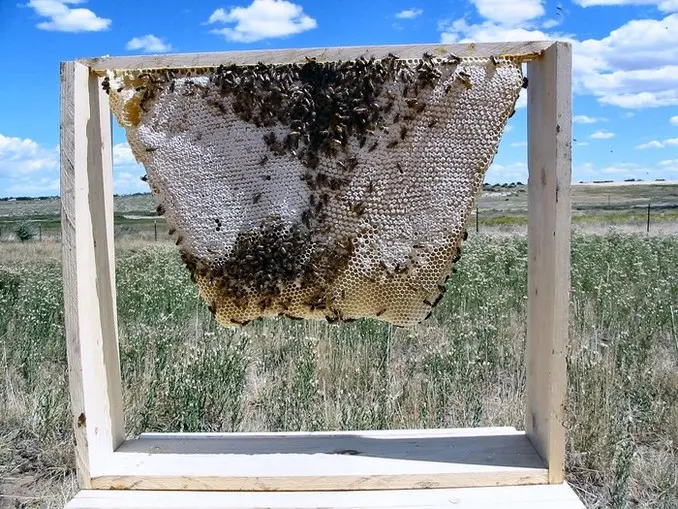Nurturing Your Bee Colony with the Right Feed

-The buzz on the best bee feed.
Starting a new chapter with your top bar hive? Let’s talk about making sure your bees are well-fed and thriving. Because a well-fed hive is a happy hive, am I right?
When it comes to feeding:
- Keep all that yummy feed inside the top bar hive.
- Bee-stored honey/pollen combs are the crème de la crème of feed.
- Sugar can step in as a honey substitute.
- Pollen substitute can play backup but can’t steal the show from the real deal.
- Be mindful not to mess with hive ventilation.
- And for the love of honey, don’t let any feed get cozy with the comb.
Bees have a sixth sense for surplus feed. If it drops below a critical level, the bees might:
- Scale back on brood rearing.
- Get a bit cannibalistic with drone and worker brood.
- Slow down their hive hustle.
- Decrease their foraging game.
Feeding Combs: The Sweet Spot
The absolute best feed is honey and pollen in a beeswax comb. Smart beekeepers stash enough comb for emergency feeding. Why comb?
- It works when it’s too chilly for other methods.
- No bee drowning incidents here.
- No fermentation fuss.
- Surplus combs aren’t treated like trash.
- It’s a neat and tidy solution.
- Minimal prep needed.
- And it won’t kickstart any robbing.
Just pop those feed frames into the top bar hive next to the buzzing cluster. A tiny bit of exposed honey using a cappings scratcher, and the bees will uncover more as they need it.
Sugar Sweetness
Granulated Sugar
Best served when the bees can take to the skies. Toss that sugar inside the hive, away from the entrance. Bees will work their magic, gathering water to liquefy it. But don’t go overboard, or they’ll ditch it once nectar becomes available.
Baker’s Sugar
Not your typical confectioners sugar. Bees still need water to make it liquid gold, but they won’t toss it out like they do with chunkier sugar. They’ll keep savoring it as needed.
Bee Candy
A sugar-water blend cooked to the soft ball stage. Perfect when the bees are grounded. Find recipes online; it’s a breeze to whip up with simple ingredients: water, sugar, and heat.
Fondant
Solid sugar in a creamy bee candy form, softened by whipping in some air. Recipes? You got it, check the web.
Baker’s Fondant
Large blocks of sugar, water, and air sold to the big-league bakeries. A fancy choice for bee candy or fondant.
Sugar Syrup: Liquid Gold
Best served when the bees are feeling fly.
For cold days, a thick 2:1 sugar syrup is a winner. Warmer weather? Opt for a thinner 1:1 sugar syrup. Keep the hive cozy and feed syrup in ways that keep the colony warm.
Watch out, though—syrup that goes unconsumed can ferment. And fermented syrup? Not on the bees’ menu. Some beekeepers add things to prevent fermentation, but what does it do to those beneficial gut bacteria?
Containers
Several ways to feed sugar syrup in a top bar hive. If the bees aren’t clustered and there’s room away from the entrance:
- Fill a container with syrup.
- Go for a quail or dribble type feeder.
- Pop in floats to save the bees from accidental swimming.
- In bad weather, tuck the feed inside the hive where the bees can reach it.
Two-Liter Pop Bottle
Craft a special top bar that welcomes the capped end of a 2L pop bottle:
- Drill a hole in the top bar that lets the cap in but is smaller than the bottle’s collar.
- Drill a few small holes in the bottle cap.
- Fill the bottle to the brim with syrup.
- Screw the cap on tight.
- Set it in the hole in the special top bar.
- Place this top bar close to the cluster in cold weather.
No need to crack open the hive when feeding this way. Swap the empty bottle for a full one. Some pros use this method through a migratory covery.
Baggie Feeders
For some beekeepers, baggie feeders do the trick:
- Fill a plastic ziplock baggie with syrup, not too tight.
- Lay the baggie inside the top bar hive near the comb.
- Cut a few slits in the top of the baggie.
I’ve given them a whirl, but they tend to be a bit leaky and less than satisfying.
Division Board Feeders
My buddy Barry rocks a top bar hive with space for a deep frame beneath the top bar. He screws a standard division board feeder to a top bar and uses it to feed his bees. Remember, division board feeders need floats to keep bees from turning into tiny swimmers.
Pollen Power-Up
Inside
Feeding pollen supplement inside a top bar hive is a bit of a puzzle.
Thin patties pushed right under the broodnest seem to work best. Unlike sugar, bees won’t devour pollen supplement below the broodnest unless they’re in a serious food crisis. If they’re not starving, it’s trash to them, and out it goes.
There’s not much space for thick patties under the comb, and placing them behind the broodnest doesn’t hit the mark.
Thin patties dry out fast, thanks to the bees’ ventilation game. Once dry, it’s bye-bye pollen patty.
Mixing pollen supplement into bee candy or fondant might be worth a shot, although I’ve never given it a whirl.
Outside
When the bees are in flight mode, a dry, powdery, flour-like pollen substitute is the way to go. Just keep it safe from rain or moisture, as once it hardens, the bees aren’t interested.
-Buzzingly yours, D 🐝🤠
